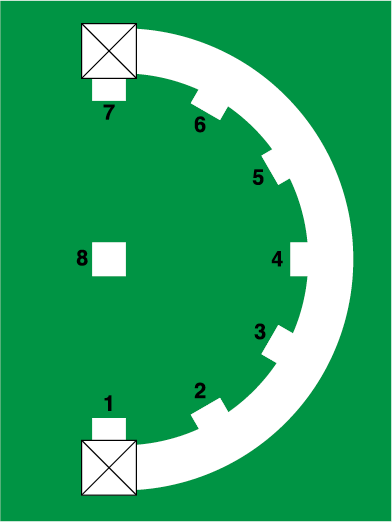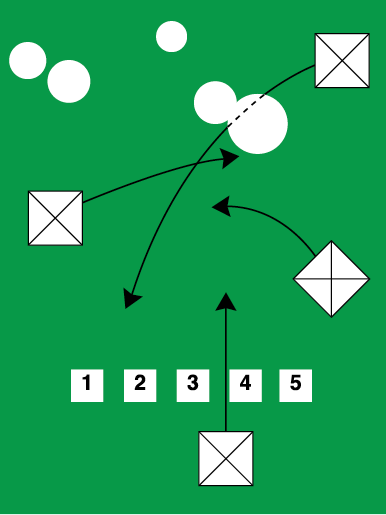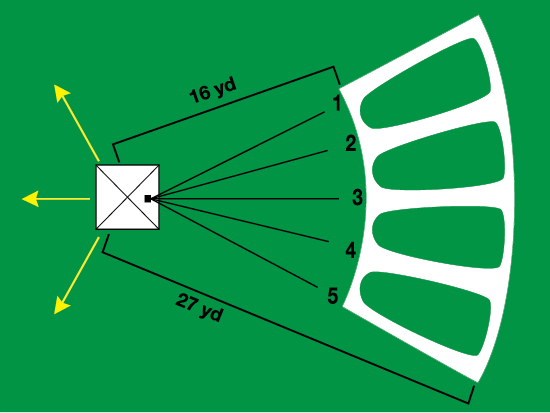Preparing for the 4-H State Invitational Shotgun Events
The 4-H State Invitational Shotgun Events are some of the most fun and eye-opening events that we have in the 4-H Shooting Sports program. It is definitely a departure from the Clover Clay course that is seen at the local and district levels of competition. At these events, participants are faced with three different shotgun “games,” all designed to give 4-H’ers a more advanced competition and a small introduction to what they might see at the national championship.
Often, 4-H’ers who compete at the State Invitational have never shot in any of the three events, so when they step onto the range, they are surprised by the new layout and procedures. The goal of this publication is to describe how each of the events will be conducted, as well as give some helpful hints that make the courses of fire move smoothly and efficiently for all involved.
Why are State Invitational events so different from district events? Because 4-H is about developing young people, and an essential part of this development is having opportunities to take on increasingly difficult challenges. As 4-H’ers develop new skills, their ability to handle new challenges also improves.
Senior 4-H’ers who make it to the State Invitational will face events they may not have encountered before. As they take on this new skill level, it is critical that instructors are there to guide participants to future success.
4-H’ers in the shotgun discipline at the State Invitational will participate in skeet, trap, and sporting clays (true or five-stand). 4-H’ers who are accustomed to shooting clover clays will witness and practice what is expected at a national event.
The 4-H Shooting Sports State Championship Rulebook (Extension Publication 2751) describes the following courses of fire and the number of targets that will be presented to each shooter. A round for any of the three events consists of 25 targets. Note that the individual tie-breaker procedure is also included.
Skeet
Event: Standard NSSA (American) skeet
Course of fire: Two rounds of 25 targets
Shoot-offs: Doubles from stations 3, 4, and 5; miss-and-out by station
Time limit: Shooters will fire in an expeditious manner, avoiding unnecessary delay; shooters should be prepared to take the field 45 minutes to 1 hour before their scheduled firing time.
Equipment: Any shotgun (12-gauge or smaller) that fires a shot charge meeting the requirements of the NGB
Tie-breaker: A tie-breaker will be called to establish the top eight individuals. Shooters will shoot doubles at stations 3, 4, and 5. Miss-and-out by station until all ties are broken.
Procedure
Station 3 – high house first
Station 4 – high house first
Station 5 – low house first
Station 4 – low house first
Repeat as needed
National Governing Board
National Skeet Shooting Association http://nssa-nsca.org/

Sporting Clays
Management determines the sporting clays course. The course of fire is flexible depending upon the capabilities of the facility and can include up to 50 sporting clays targets. The course will include at least two layouts using mixed targets of management’s choice and placement. No FITASC (Federation Internationale de Tir Aux Sportives de Chasse).
Event: 50-target event
Course of fire: Any combination of 25 targets
Shoot-offs: Five pairs as arranged by the shoot management
Time limit: Shooters will fire in an expeditious manner, avoiding unnecessary delay. Shooters should be prepared to take the field 45 minutes to 1 hour before their scheduled firing time.
Equipment: Any shotgun (12-gauge or smaller) firing a shot charge meeting the requirements of the NGB may be used. Choke tubes may be changed between stands only.
Tie-breaker: A tie-breaker will be called to establish the top eight individuals. A shoot-off will begin with five challenging pairs from a five-stand course. Match officials determine shooting order and position. Placing is determined by the highest total of targets broken out of the round of five pairs (10 targets). If ties persist, range officials may establish five new or different pairs for another round, and so on.
National Governing Board
National Sporting Clays Association http://nssa-nsca.org/

Trap
Event: Standard ATA (American) trap (16 yards)
Course of fire: Two rounds of 25 targets. Targets consist of five targets from each of five shooting stations—all at a 16-yard distance.
Shoot-offs: Five targets from stations 1 and 5 from the 21-yard line. Management may increase the distance to 27 yards if required to break ties.
Time limit: Shooters will fire in an expeditious manner, avoiding unnecessary delay; they should be prepared to take the field up to 1 hour before listed start time.
Equipment: Any shotgun (12-gauge or smaller) firing a shot charge meeting the requirements of the NGB
Tie-breaking: A tie-breaker will be called to establish the top eight individuals.
Shoot-offs will be considered and interpreted the same as registered events. All applicable ATA rules apply unless otherwise agreed upon by all contestants. The management of a tournament may rule that ties be carried over to the first (or more if needed) sub-event on the next like event.
Whenever possible, all ties will be shot off in a manner designated by shoot management. Unless otherwise specified by the management, ties on single-target events will be shot off in 25-target events.
Starting posts for the rotation are as follows:
If one shooter*: post number 2
If two shooters: post numbers 2 and 4
If three shooters: post numbers 2, 3, and 4
If four shooters: post numbers 2, 3, 4, and 5
If five shooters: post numbers 1, 2, 3, 4, and 5
If more than five shooters are involved in the tie, they will be divided as equally as possible into two or more squads as directed by management.
*The one-shooter scenario is listed in the rare case that one shooter shoots at a much longer handicap than the others.
If subsequent shoot-offs are necessary, the post will be rotated clockwise, with the shooter from post 1 advancing to post 2 and the shooter from post 5 rotating to post 1, or to the post dictated by the number of shooters remaining, but always in clockwise rotation.
The person who breaks the greatest number of targets after the completion of all the stations has won the tie-breaker.
If, after one round, all placings are not determined, the yardage may be increased.
An overall tie-breaker will be called to establish the top individuals at the State Invitational. The tie-breaker will consist of 10 targets for each event conducted during the State Invitational Shotgun event.
Skeet: One pair from stations 2, 3, 4, 5, and 6 = 10 total targets
Trap: Five targets each from stations 1 and 5 = 10 total targets
Sporting clays: Five pairs from stations determined by chief range officer and event coordinator
National Governing Board
Amateur Trap Association http://www.shootata.com/

Overall Tie-Breaker
Invariably, ties for the overall cumulative total for the three events will take place. The established procedure for the overall tie-breaker is described below. Note that each of the three events is represented in the tie-breaker procedure to ensure one does not outweigh the others in scope and magnitude for the overall match itself.
An overall tie-breaker will be called to establish the top 16 individuals at the State Invitational. The tie-breaker will consist of 10 targets for each event that is conducted during the State Invitational Shotgun event.
Skeet: One pair from stations 2, 3, 4, 5, and 6 = 10 total targets
Trap: Five targets from stations 1 and 5 = 10 targets
Sporting clays: Five pairs from stations determined by chief range officer and event coordinator
The games of the State Shotgun Invitational exhibit an amazing array of different target presentations. YouTube videos of each event are helpful to visual learners and those who may not have participated in the state event before.
From the first-time participant to the veteran 4-H member, all presentations are the same. The opportunity for success still lies in the hands and eyes of those who sky-gaze for the orange disks; no matter your age or expertise, a well-placed shot and a target’s disintegration will always bring a sense of pride and elation. Keep your eyes skyward and your hopes high with a smile of satisfaction as they fall from the sky!
Common Terms
Clay: A round, concave, orange disk made of asphalt that is launched from the thrower as a target.
Clover clays: A modified course of fire that is derived from the Sporting Clays shotgun event.
Follow-through: The method of keeping the barrel of the gun in motion while still retaining target acquisition.
High house: Trap house located to the left of the participant in the skeet event.
Low house: Trap house located to the right of the participant in the skeet event.
NGB: National Governing Body.
Pull: The command given by the shooter for the target to be thrown from the machine.
Rabbit: Similar to flight targets; rabbits are round, orange disks that are thrown from the trap machine and bounce along the ground in a straight-line fashion.
Shooter’s choice: The participant may choose a single target from one of the two outside throwers.
Station: A location on the range in which the participant stands to view the course of fire for that location.
Trap house: The small building to the front of the range that contains an oscillating thrower that randomly throws targets in a non-distinctive pattern.
The information given here is for educational purposes only. References to commercial products, trade names, or suppliers are made with the understanding that no endorsement is implied and that no discrimination against other products or suppliers is intended.
Publication 3073 (POD-05-23)
Distributed by Reid Nevins, 4-H Environmental Science and Education Specialist, Extension Center for 4-H Youth Development.
The Mississippi State University Extension Service is working to ensure all web content is accessible to all users. If you need assistance accessing any of our content, please email the webteam or call 662-325-2262.


